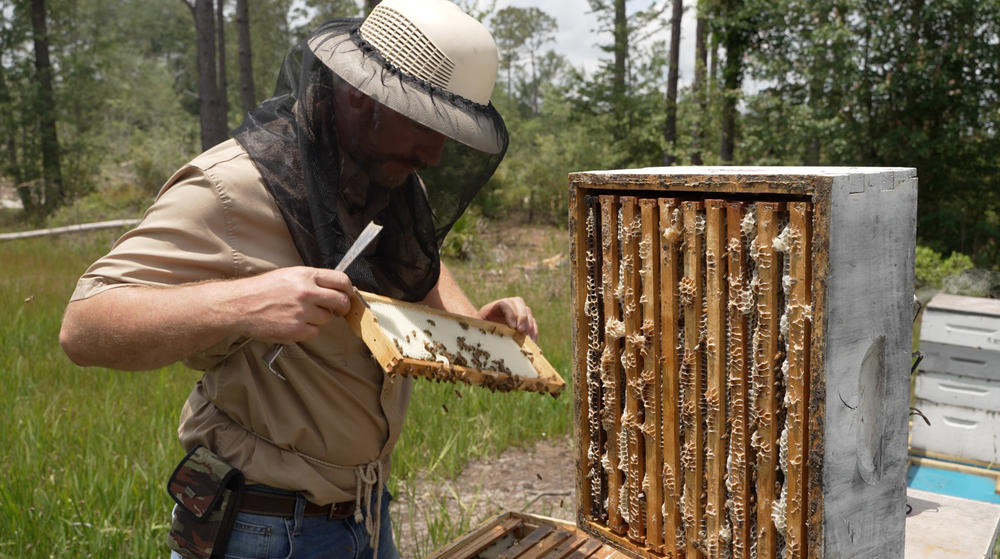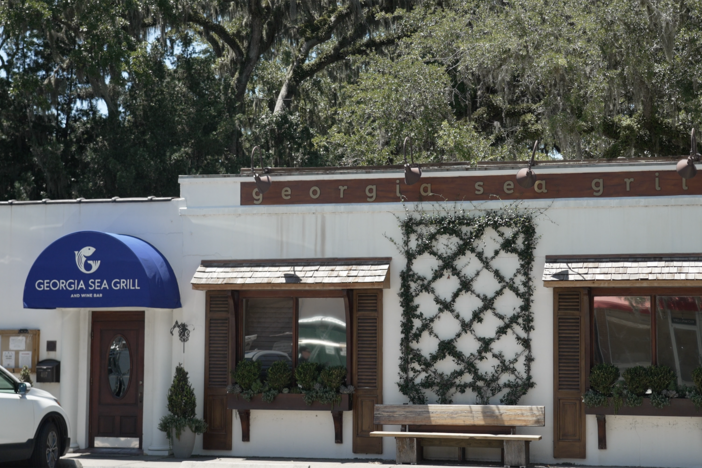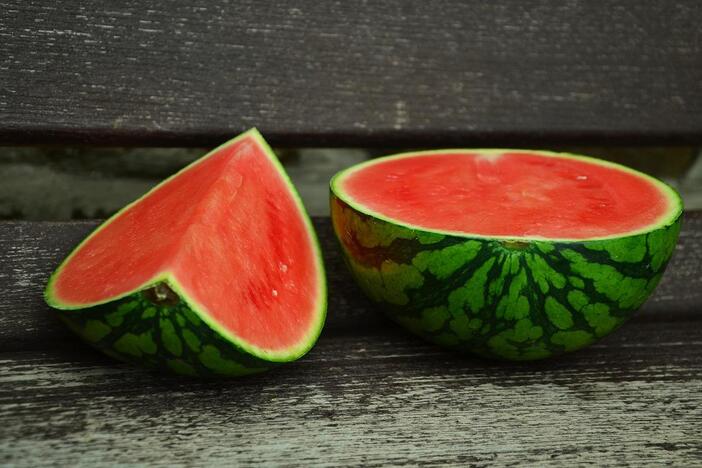
Section Branding
Header Content
A Fork in the Road Podcast: Bruce's Nut-N-Honey Farm
Primary Content
Homerville, Ga., is home to the Clinch County Honey Trail, where beekeeping has been a way of life and source of income for many generations. In this episode of the Fork in the Road podcast, we'll talk with Ben Bruce, owner of Bruce's Nut-N-Honey Farm and Bruce's Honey Shack, to learn what the buzz is all about.

David Zelski: So you're going into their hive, why are they not feeling threatened right now?
Ben Bruce: I reckon they know me.
David Zelski: Bees. As kids, we were afraid they would sting us. But it rarely happened. And as we got older, we learned they play one of the most important parts of our whole ecosystem. By pollinating plants, bees help breed, grow, and produce the food we eat every day. They also make something that's not half bad in a nice cup of Earl Grey. In Homerville, Ga., we got to see some bees at work.
Theme Song: There's dirt on my hands, strong like a tree. There's roots where I stand.
David Zelski: I'm David Zelski, and this is the Fork in the Road podcast presented by Georgia Grown and the fine folks at Georgia Public Broadcasting. Each episode, we feature stories from Georgia's farmers, fishermen, merchants, artisans, chefs, and others who help provide Georgia Grown products to folks in the Peach State and beyond. Today, we are in South Georgia. Halfway between Valdosta and Waycross on Highway 84 sits Homerville and the Clinch County Honey Trail, where beekeeping has been a way of life and a source of income for decades. This is where we will find Ben Bruce. He's the owner of Bruce's Nut-N-Honey Farm and its store, The Honey Shack. Ben has so many bees that he can't keep count. How many bees do you have?
Ben Bruce: I don't have a clue. A bunch. Probably 30 or 40,000 to each colony. So, you know, you take that into consideration with 2 or 3,000 hives. So that's a lot of bees.
David Zelski: That is a lot bees. Just a short drive from downtown Homerville, Bruce's Honey Shack is a charming little store that features Georgia Grown products from all over, including the huge variety of honey produced on site.
Ben Bruce: We've got a lot of Georgia Grown products in here, and we've got Goodson's Pecans, and we get the cheese straws or Southern Cheese Straws. And I mean, we've got — we've tried to specialize in a lot of Georgia Grown products in the store. So, I mean, we've got other stuff. We had to, to fill up the store because we just have all Georgia stuff. We tried to for a while, but it just there wasn't enough stuff through — throughout Georgia. But we got a lot of different varieties of honey and mostly all the honeys that we have in here, most of them we produce or we got local beekeepers that help with our with our production of it. But we do have a few that we outsource. Like get in other places, let's just say orange blossom from Florida, but most of, 90% of our business is the comb boxes that we've got over there.
David Zelski: The comb boxes sold at The Honey Shack are 10-ounce containers with a slice of unprocessed honeycomb cut directly from the beehive. When it comes to honey, that's as fresh as it gets.
Ben Bruce: That's in its rawest form. I mean, it's just like it's just straight out of the hive. I mean, we just basically pull a frame out and cut it, and it's just straight out the beehive.
David Zelski: Bruce's Nut-N-Honey Farm also wholesales their honey to other stores across the country for them to sell. Explain how the private label works.
Ben Bruce: That's just like it might be other companies that do get our same honey and then they just get their label put on it. I mean, it's our honey, but they just get their label on.
David Zelski: There's a good chance there's honey out there. You don't realize you're getting Bruce's Honey.
Ben Bruce: It could be ours. That's right. Because, I mean, we send it all over the United States.
David Zelski: The store also offers raw, unfiltered, private selection honey — which won The University of Georgia's Flavor of Georgia Award.
Ben Bruce: Our private selection is probably the one that we won the Flavor of Georgia with it. So but it's what comes from the comb that I was talking about. It's what whenever we're cutting that comb, all the honey that drips off of that that we get when we do that, it's like it is purest form. It's never nothing that we — we don't do anything to that. Not extract, it's not heated or anything. We just jar it up and it's all pure.
David Zelski: For Ben, the honey business is a family affair. While he makes his daily rounds tending to the yards at Bruce's Nut-N-Honey Farm, where he keeps thousands of beehives, he may not always be at the store to greet you, but chances are someone from his family will.
Ben Bruce: My wife helps some and my mom and dad actually help us with the packing. And and we have quite a few employees. But I mean, we, you know, some family members that help, too.
David Zelski: And at Bruce's Honey Shack, they use the honor system for making purchases. It's a testament to their trust in the community and the goodness of the folks that shop there.
Ben Bruce: People just pull up and they just there's a the little ol' book out there they can sign and then they can take and just get a jar of honey and put the money in the metal container we got out there for it.
David Zelski: Says a lot for the folks that live around here.
Ben Bruce: Yeah there's a lot of honest people in the world.
David Zelski: After a while of talking, we hopped in Ben's truck and he took me through some winding back roads to visit the fields where he keeps his hives.
Ben Bruce: I'm going to take you out a little bit different. I mean, we'll still come out one of them roads.
David Zelski: Back at the Honey Shack, Ben told me about his dad's humble beginnings when he founded Bruce's Nut-N-Honey Farm LLC over 40 years ago.
Ben Bruce: My dad started with one hive back in the '80s. And then we come along and just gradually started getting more and more hives. And then we took and, uh, expanded and started actually packing up honey. And then when we started packing up honey, we started with the honor system we got over on the side. And then from there we opened up this retail shop in probably 2014.
David Zelski: Ben says, one of the things that makes Georgia honey stand out is how long it lasts. On the Clinch County Honey Trail, that's earned them widespread recognition.
Ben Bruce: Like Clinch County, like in this area, like, our cut comb it's like world famous. It goes all over United States because of its slow granulation period. I mean most places make comb honey, but it granulates really fast.
David Zelski: Now, let's stop for a minute and answer the obvious question: what is honey granulation? Well, it is sometimes referred to as crystallization or sugaring. A big misconception is that when honey crystallizes, it has gone bad. Not true. Honey does not spoil. In fact, it's actually a sign of real quality honey. Granulation is a natural characteristic of pure honey, which does not harm it or indicate any deterioration of the honey at all. Got it? Good. We're all on the same page.
David Zelski: So how long can it hold for?
Ben Bruce: Oh, we've had some it's been up to about two years before. And if it's in the right — right climate condition, I mean, yeah it can go at least two years or better, probably. But most of the time it'll get eat up within a year, you know, in most circumstances.
David Zelski: Definitely wouldn't that last long at my house. Bruce's Nut-N-Honey Farm has come a long way since Ben's father started the company with a single hive. They now have thousands of hives scattered throughout the property in over 30 different yards, and each location can yield an impressive amount of honey. So how many barrels are you getting from each of these locations?
Ben Bruce: Oh, hopefully, if they do good, you ought to get a couple of — a couple of — a couple of drums from each location.
David Zelski: As we exit Ben's truck and approach a yard filled with wooden beehives, the sun pops out from behind the clouds. There's a definite buzz in the air.
Ben Bruce: Sun's kind of coming back out. You can actually see the bees starting to fly a little bit better. You see them in air. You smell it. You can smell it if you.
David Zelski: I smell it for sure.
Ben Bruce: Yeah, you smell the sweetness. I mean, the sun's coming back out and they're starting to fly again, but I think that's a mating swarm. It's a real small swarm up there.
David Zelski: We look up and see a group of bees just congregating on a nearby tree branch. What is that called?
Ben Bruce: It's a mating swarm.
David Zelski: Oh wow.
Ben Bruce: They'll be a lot smaller than, like, a regular swarm coming out of a hive. It's probably just a queen. One of these hives, it's lost a queen. It's getting mated, they'll land in like a little swarm.
David Zelski: Those are all bees in there.
Ben Bruce: That's a whole, just a whole glob of bees up there.
David Zelski: If I get below it, they're going to get ticked off?
Ben Bruce: What now?
David Zelski: If I get right below it?
Ben Bruce: Oh, no, no. You should be fine. You should be fine.
David Zelski: Now, before we step to these honey bees, I think it's time for a quick honey 101. Hey, that's pretty fun to say, honey 101. Honey 101. Honey 101. Hmm. Well, anyway. Okay, honey starts as a flower nectar collected by bees for food. In their nest, bees build honeycombs out of wax and store the nectar in tiny cells. The shape of the honeycomb and the constant fanning of bees' wings inside their nest causes evaporation, creating the honey which preserves the food. Bees then make a wax cap to seal off each cell. Beekeepers build wooden boxes with stacks of frames and harvest the honey by collecting the honeycomb frames and scraping off the wax caps. Once the caps are removed, the frames are placed in an extractor, a centrifuge that spins the frames, forcing honey out of the comb. Back in the yard at Bruce's Nut-N-Honey Farm, Ben cracks open one of the many wooden boxes filled with honeycomb panels. The warm sweetness wafts through my nose.
David Zelski: So you're going into their hive. Why are they not feeling threatened right now?
Ben Bruce: I reckon they know me. We smoked them and we done what we were supposed to do.
David Zelski: Wow.
David Zelski: Besides the cool looking protective gear, which is the first image in your mind when you think of someone in the bee business, another important tool in any beekeeper's tool kit is the smoker. It's a steel canister that produces cool smoke which calm the bees and help prevent stings while you harvest. Ben explains to me how it works.
Ben Bruce: They think it's like a forest fire, and so they sort of gather up honey in the hive and fill their self up. So they're happy and then they leave or they're ready to leave if they — the hive gets burned.
David Zelski: And tell me how the smoke works, too, with their bodies, like what it's doing to them.
Ben Bruce: Well, it just calms them down because it makes them gorge theirself with honey.
David Zelski: Ben looks over the honeycomb frame with a careful eye. And tell me what we're looking for here.
Ben Bruce: I'm just looking. Just to see how much they've done since we was in here last. But that's — that's like eggs. And you got the honey that's around it.
David Zelski: So the dark is the eggs, the white is the honey, and then they cap it?
Ben Bruce: That's right. Then they capped — capped over it. That's like the comb that we cut to put in the jars.
David Zelski: How many of these hives do you have out here?
Ben Bruce: Uh, there's usually anywhere from — we usually have anywhere from 40 to 80 to a yard.
David Zelski: This is just one of many yards.
Ben Bruce: Oh, yeah.
David Zelski: Tell me what flowers these.
Ben Bruce: This is all what they're making now is Gallbery but, I mean, there's there's probably going to be some Tupelo mixed in with it, and there'll be some Palmetto before it's over with. And and then another bush called Senna bush.
David Zelski: The different honey varieties are named from the flowers and the foliage the bees make the honey from. The wide variety of foliage on Ben's farm produces a wide variety of honey, all with different flavors and consistencies.
David Zelski: And you kind of never know exactly what it's going to be like.
Ben Bruce: No, like each frame could be like when we're pulling out the frames that you can see the you can actually see the different, like where they start and stop different honey flows, and then you can see the different colors of the honey and kind of tell what it's going to be.
David Zelski: Also different honey is made in different seasons.
Ben Bruce: Well, we start out in the spring with something called TyTy, which is a bakery-grade honey, and then we go — like, then our next crop is the Gallberry, and then it's palmetto and senna bush that's most of the main honeys we have. And then we have — we also have some cotton, cotton honey that we make in like in the summer.
David Zelski: Cotton Honey? Now, that sounds wild. At Bruce's Nut-N-Honey Farm, they get that particular variety in the summertime, when the bees are moved to the cotton fields.
Ben Bruce: When we take them to the cotton fields after that, and they kind of stay there, what they produce up there. And a lot of times we just let them have that crop and we get some cotton honey from them. But a lot of times we just let them have that as their winter — winter crop for that. That's like their groceries at that point.
David Zelski: Clinch County bees sometimes get shipped outside the state to pollinate crops. This can result in some unexpected honey that you might not want to sample.
David Zelski: So you take your bees to different spots all around.
Ben Bruce: Yeah. They go to California. Yeah, we send them out to California. They're around Bakersfield and places. But that's where these bees have come from, is California. They stay out there about a month and a half, usually, whenever they go to California.
David Zelski: Is that during the cold months?
Ben Bruce: Well, it'll be from January, they go out the end of January. So they stay February, March, and then they're back here by the first you know, in the end of March or first of April, they're usually back here.
David Zelski: Is that for the bees' safety? How is it or are they just working out there?
Ben Bruce: No, that's just they working almonds out there. They're pollinating. It takes all those bees to do all the almond crop.
David Zelski: Oh wow.
Ben Bruce: So yeah, but the almond, they do make a little nectar off of almond. But boy, you talk about bitter. If you think about the worst medicine you could take, that would be the almond honey. I mean, it's bitter. I don't know what makes it that bitter, but it's it's really, it's a bitter — it's a bitter honey.
David Zelski: We'll stick with gallberries and bayberries.
Ben Bruce: Yeah. I don't even know how the bees even tote it thinking it's something sweet. 'Cuz it's not. It's not sweet; it's bitter.
David Zelski: So we'll stick with Georgia honey.
Ben Bruce: That's right. That's right.
David Zelski: This honey looks so good. I want to eat it right off the comb. And I'm not the only one. There can be safety concerns by some unwanted visitors.
David Zelski: What are you looking for? What are some of the dangers to the bees every season?
Ben Bruce: We've been kind of lazy this year about our fences or whatever, but the bears is a big thing out here. Coming in, because they'll go to smelling the honey. Once you get it, once you get hives stacked up like now. But I don't know. I haven't seen that much sign this year, so haven't been — that's the reason we haven't got the fences all hot. But normally we do.
David Zelski: So bears. There really are Winnie the Poohs out there?
Ben Bruce: Oh yeah. They'll go to smelling the honey and they get to be an issue. But that's really one of the biggest thing. And then like this time of year, wildfires get to be a big, big issue because you worrying about, you know, you get all this honey, you get to this point and you know, when you bring them out here, you only got one box on them and you get to this point, you start, you know, you starting to get into your livelihood then.
David Zelski: In the hive, we see some baby bees and these little guys aren't making honey of their own yet. But Ben tells me they will be soon.
Ben Bruce: This is all like baby bees. And this is what you want to see now, because they're getting ready to make honey, because all this stuff is fixing to hatch out.
David Zelski: And how long after the bees hatch — the baby bees hatch — how long after until they start making honey, too?
Ben Bruce: Well, they live a 21-day cycle during during this time of the year, their wings will just fall off of them whenever they're out making honey. So they when they first come out — I don't know exactly the the dates on how long, which does — but once they come out of the cell, they actually are like a brood tender. They stay in the hive and tend brood and then after they're out for a few days or whatever, then they actually go out and start going into the — they start collecting nectar.
David Zelski: These babies are cute and all, but we'd be remiss if we didn't mention their mother. The one who makes this colony possible. The queen bee herself! — The queen bee. The queen bee is selected by the worker bees to reproduce for the whole colony. There's only one queen bee per hive, and they can produce up to 5,000 eggs per day. She's fed only with royal jelly, a protein-rich substance which worker bees produce from a gland in their heads. Bees feed royal jelly to all their babies and use it to preserve the queen.
Ben Bruce: That all that shininess in there.
David Zelski: Explain what royal jelly does.
Ben Bruce: That's what they put on the bees to — they actually put more of the royal jelly on a queen if they were raising it. But that's just what they add in there. That's like the food they feed to the babies.
David Zelski: And each stack has a queen, right?
Ben Bruce: Oh, yeah. Each. Each, each hive will have a queen in it.
David Zelski: As the sun sets, we hop in Ben's truck and head back to The Honey Shack. I'll definitely be dropping some money in the container for a few jars of honey and some comb boxes to take home. From flower petals across the landscape to a plastic bear on your kitchen counter, the journey which honey takes to creation is a fascinating one. Special thanks to the bees that make it happen. I sure am glad I got to spend some time with Ben on Bruce's Nut-N-Honey Farm to witness this whole sticky saga.
For more stories like this one, you can watch A Fork in the Road on GPB-TV or any time on the GPB.org website. GPB.org/Podcasts is where you can listen to and subscribe to this p odcast or download it on your favorite podcast platform.
I'm David Zelski. Thanks for listening to A Fork in the Road.
The A Fork in the Road TV show airs Saturdays at noon and Sundays at 6:30 a.m. on GPB-TV. Check your local listings for other replays throughout the week and watch all episodes anytime at GPB.org/ForkintheRoad. Please download and subscribe to the Fork in the Road podcast at GPB.org/ForkintheRoadpodcast or on your favorite podcast platform as well.

Homerville, Ga., is home to the Clinch County Honey Trail, where beekeeping has been a way of life and source of income for many generations. In this episode of the Fork in the Road podcast, we'll talk with Ben Bruce, owner of Bruce's Nut-N-Honey Farm and Bruce's Honey Shack, to learn what the buzz is all about.





